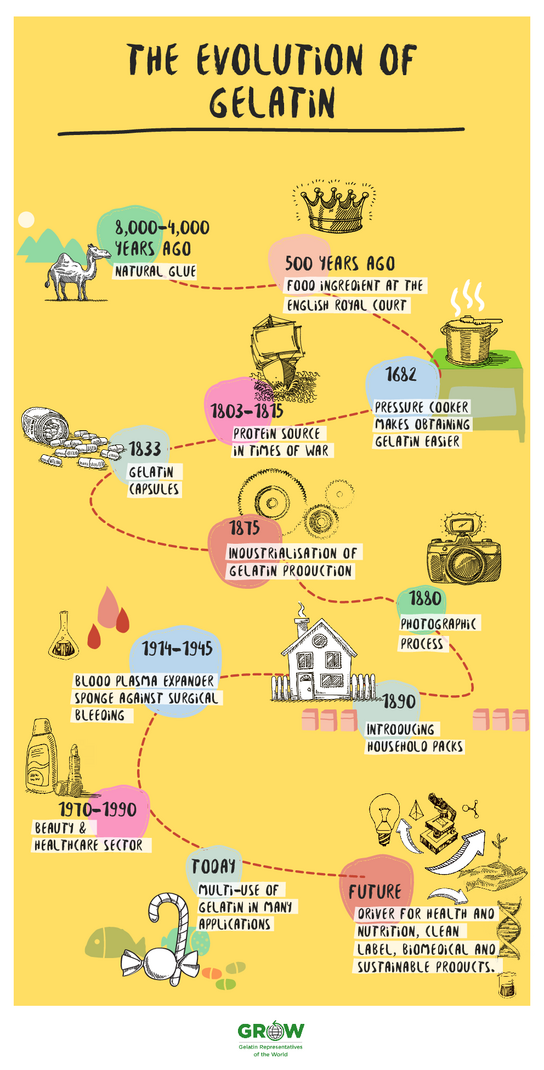Gelatin – Yesterday, today and tomorrow
The production of gelatin-like substances can be traced back to the age of the Ancient Egyptians. Sources also show that in centuries past, delicacies such as trout or fruit in gelatin were considered a special treat at feasts. Today, the all-rounder is used in various economic sectors and for a wide range of products. It is of especial importance to the food, pharmaceutical and photo industries. In the future, gelatin will continue to be the starting material for innovations in a diverse range of sectors to sustainably protect health, nature and the environment.

-
8,000–4,000 years ago
Gelatin-like mixtures and collagen produced from animal tissue were used as a natural glue beginning with the cave dwellers up until the Ancient Egyptians. However, the first patent for a gelatin-based adhesive was granted in England in 1754.
-
500 years ago
Jelly made from calves was used as a food ingredient at the English royal court. Pickled dishes with “glittering calves’ foot jelly” were commonly served at the banquets of King Henry VIII.
-
1682
The French mathematician Denis Papin invented a pressure cooker he called a “digester” and described a cooking process in which he tried to obtain a jelly-like mixture from bones.
-
1803–1815
During the Napoleonic Wars, gelatin experienced its first major boom when it was used as a source of protein during the sea blockade by the British navy when meat became scarce.
-
1833
Gelatin began to be used in the medical sector to cover the unpleasant taste of medicinal substances and to enable swallowing after the young pharmacy student F. A. B. Mothes invented an instrument to make gelatin capsules. The one-piece gelatin capsule has since become a well-established pharmaceutical item.
-
1875
This year is considered to be a milestone in modern gelatin manufacture. Thanks to the emergence of small factories, it was now possible to industrially manufacture large quantities of gelatin from valuable by-products from the food industry.
-
1880
Gelatin simplified the photographic process, which in turn increased its popularity with the general public. Ready-to-use dry photographic plates coated with gelatin emulsion became available, taking the complexity out of photography through the introduction of negatives.
-
1914-1945
During World War I, the use of gelatin-based substances as blood replacement agents or plasma expanders was intensively researched. In World War II, this method was used on a large scale. As of 1940, gelatin sponges became indispensable as haemostatic agents against surgical bleeding.
-
1890
Gelatin for household use was introduced.
-
1970-1990
As a “liquid protein” gelatin experienced a surge in demand in the growing beauty & healthcare sector.
-
Today
Multi-use of gelatin and gelatin-based products across all industries:
- Food c. 59%
- Pharma c. 31%
- Photo/technical c. 2%
- Other c. 8%
-
Future – Gelatin as a hidden innovation driver in a wide range of fields.
Gelatin has many successful and well-known uses in a wide range of fields, from cosmetics and food preparation to pharmaceutical and medical applications. And as a versatile natural product, gelatin continues to inspire researchers and scientists all over the world to discover new and often unexpected uses. For example, research on gelatin/collagen peptides fighting non-communicable diseases (NCD) by helping to reduce sugar, fat and salt in food ist already in progress.
sketches: © iStock.com/FrankRamspott, candy: © iStock.com/MariaTkach, gear transmission: © iStock.com/martin951, research & future: © iStock.com/veekicl, arrows: © iStock.com/pseudodaemon, DNA: © iStock.com/saemilee, hand with plant: © iStock.com/LEOcrafts
